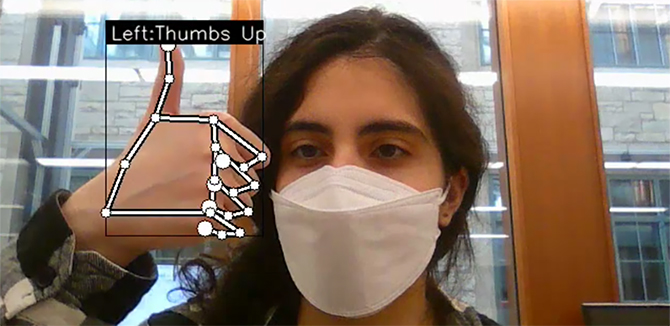Witnessing Machine Learning's Potential
Ava Zahedi looks back on how she used machine learning in MSR and how those experiences prepared her for her current work as a robotics and automation software engineer at Kasalis.

Recent advances in machine learning (ML) have changed the way that industry and academia approach robotics. Powered by artificial intelligence, robots are moving out of the structured environments of tightly controlled factory floors and into the real world.
Ava Zahedi (MSR '23) is already well-versed in ML's potential to revolutionize the field of robotics.
As a student in Northwestern Engineering's Master of Science in Robotics (MSR) program, Zahedi gained experience with machine learning throughout the curriculum.
For her independent winter project, she established non-verbal communication with the Unitree Go1 quadruped. Part of that process involved using a machine learning model that took in hand gesture data and returned a label.
"Based on the hand gesture the user showed, I could signal the Go1 to move in different ways," Zahedi said. "For example, I would show the camera a thumbs-up, and the model would recognize this and ultimately tell the Go1 to walk forward."
For her final project, Zahedi implemented autonomous grasping with a Kinova Jaco arm. The goal was to help people who are unable to perform certain daily tasks, and its success would not have been possible if she did not rely on machine learning.
"Without leveraging machine learning, I would have been limited to picking a few primitive grasps that may only work for a few primitive shapes," she said. "In both of these projects, using machine learning was a huge help toward achieving my goals, and it allowed me to do so more efficiently."
While ML holds incredible promise, there are countless risks associated with the technology. When a model experiences a new use case, its reaction can be unexpected — and unhelpful. In many instances, it is not the best method for tackling a problem.
Zahedi works to avoid those outcomes.
As a robotics and automation software engineer at Kasalis, Zahedi writes new algorithms and tests code to integrate with existing technology systems. The company’s solutions are helping revolutionize everything from the cameras in cell phones to the collision-avoidance sensors in vehicles.
Precision is key, as a fraction of a second could mean the difference between a vehicle stopping safely and it smashing into the car in front of it.
“Each customer has unique needs,” she said. “It’s always interesting to see how to tailor software to those requirements.”
To succeed in her role, Zahedi relies on the lessons she learned in MSR — with and without machine learning.
“The flexibility of the program allows students to dive into their interests,” she said. “If someone wants to make their own model or work on a project that uses ML tools, there’s a lot of freedom to do so. MSR provides many opportunities for students to utilize ML in projects and coursework that will help prepare them for the field.”
Zahedi's comfort and preparedness with ML is thanks to MSR.
Still, she echoes a common refrain about artificial intelligence and ML: Proceed with caution.
“Machine learning is a fantastic tool for pattern recognition in dimensions that humans may not be able to see manually,” she said. “But it requires a lot of data and isn’t always the best method for tackling a problem. It’s important to assess the risk of using a model versus hard-coding specific cases depending on the application.”

